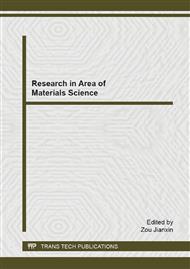[1]
K. M. Asl, F. Khomamizadeh. Effect of rare earth elements addition and T6 heat treatment on creep properties of Mg-Al-Zn alloy. Magnesium Technology 2009, 2009: 483-488.
Google Scholar
[2]
H. Somekawa, Y. Osawa, A. Singh, et al. Rare-earth free wrought-processed magnesium alloy with dispersion of quasicrystal phase. Scripta Materialia, 2009, 61(7): 705-708.
DOI: 10.1016/j.scriptamat.2009.06.008
Google Scholar
[3]
D. W. Yi, J. D. Xing, S. Q. Ma, et al. Effect of rare earth-aluminum additions on the microstructure of a semisolid low carbon Fe-B cast alloy. Materials Science and Technology, 2011, 27(10): 1518-1526.
DOI: 10.1179/026708310x12756557336391
Google Scholar
[4]
H. Shen, H. Liang, W. D. Yang, et al. Study of effect of Ce-rich mixed rare earth on corrosivity of new 5XXX series aluminum alloys. Advanced Materials Research, 2011, 314-316: 1449-1455.
DOI: 10.4028/www.scientific.net/amr.314-316.1449
Google Scholar
[5]
D. X. Yang, J. P. Xie, A. Q. Wang, et al. Effects of rare earth la on microstructures, mechanical properties and sliding wear behavior of high-aluminum zinc foundry alloy ZA30. Applied Mechanics and Materials, 2012, 117-119: 360-363.
DOI: 10.4028/www.scientific.net/amm.117-119.360
Google Scholar
[6]
W. Luo, J. Xiong, J. Wang, et al. Effects of rare earth on microstructure and properties of squeezing casting 6063 aluminum alloy. Special Casting & Nonferrous Alloys, 2012, 32(5): 476-478.
Google Scholar
[7]
J. L. Cai, D. Q. Yi, H. W. Wang, et al. Effect of Ag on precipitation behavior of Ω phase in Al-Cu-Mg alloy. Chinese Journal of Nonferrous Metals, 2011, 21(7): 1504-1512.
Google Scholar
[8]
X. Chen, Z. Y. Liu, S. Bai, et al. Alloying behavior of erbium in an Al-Cu-Mg alloy. Journal of Alloys and Compounds, 2010, 505(1): 201-205.
DOI: 10.1016/j.jallcom.2010.06.029
Google Scholar
[9]
Q. L. Pan, X. Y. Liu, S. F. Cao, et al. Study on the interrupted aging treatment of Al-Cu-Mg-Ag heat-resistant alloy. Journal of Materials Engineering, 2012, 11: 47-51.
Google Scholar
[10]
Y. X. Gu, Z. Y. Liu, D. E. Yu, et al. Effect of aging condition on the mechanical properties of an Al-Cu- Mg-Ag alloy. Advanced Materials Research, 2012, 476-478(1): 42-45.
DOI: 10.4028/www.scientific.net/amr.476-478.42
Google Scholar
[11]
B. Hammer, L. B. Hansen, J. K. Norkov. Improved adsorption energetics withen density-functional theory using revised Perdew-Burke-Emzerh of functionals. Phys. Rev. B, 1999, (59): 7413-7421.
DOI: 10.1103/physrevb.59.7413
Google Scholar
[12]
G. P. Franscis, M. C. Payne. Finite Basis Set Corrections to Total Energy Pseudopotential Calcaulations. J. Phys. Condens. Matter, 1990, (2): 4395-4404.
DOI: 10.1088/0953-8984/2/19/007
Google Scholar


